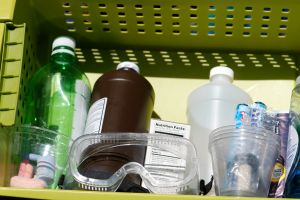What are elements, atoms and molecules? How do we study them?
Chemistry Vocabulary:
Elements– Chemists have identified substances that can not be broken down further using chemical means. These are called the elements. Examples of elements are oxygen, carbon and gold. Jefferson Lab has a list of the 10 Most abundant elements in the universe.
Atoms- Atoms are the smallest units of elements. They are also what makes up all the matter in the universe.
Molecules– Many elements are found in nature as two or more atoms interacting together. When two or more atoms interact together or bond, then the result is called a molecule.
Atoms from different elements can also form molecules. An example of a molecule of this type is water, which is formed of hydrogen and oxygen atoms.
A friend used to ask me, “Has anyone ever seen an atom?†Recently scientists have developed technology that allows us to do just that. It is called an atomic force microscope/scanning tunneling microscope. They use extremely cold conditions to hold the atoms or molecules still enough to visualize. Want to see what they look like?
A Boy And His Atom: The World’s Smallest Movie
This is a stop motion animated movie created using images from a scanning tunneling microscope. Note: This should really be called a boy and his molecule, because the researchers moved carbon monoxide (CO) molecules to create the images.
Moving Atoms: Making The World’s Smallest Movie
In the video below you can see how researchers made A Boy and His Atom. You can also see how excited the researchers are to be doing this creative project and how it has practical applications. It is well worth watching.
Related activity:
Make An Element Collection
One great way to make chemistry more concrete is to have have experience with the pure form of different elements.
Gather:
- A periodic table of the elements (About.com has some to download for free)
- Box for holding the collection
- Paper and pen or computer for generating labels
- Tape or glue (for attaching labels)
- Small vials for holding samples (optional)
- Elements
Caution:Â Some elements are gases at room temperature, and would be hard to hold in a collection. Some elements, such as mercury, beryllium, and arsenic, are toxic and should not be collected by children.
Elements that you can find at home, hardware supply stores, department stores, rock shops, etc.
- Carbon:Â coal, charcoal
- Copper:Â plumbing supplies
- Aluminum:Â foil, pots and pans
- Iron:Â nails, some magnets
- Magnesium:Â Campfire starters (warning:Â highly flammable!)
- Tin:Â new lead-free fishing sinkers
- Lead:Â older fishing sinkers (handle with rubber gloves and wash hands afterwards)
- Silicon:Â computer chips
- Platinum, gold, silver:Â jewelry, small amounts available at bead stores
- Lithium:Â specialized batteries
- Sulfur:Â rock and mineral shops
- Zinc:Â Galvanized nails, electrodes in lemon battery kits (can be toxic if sufficient amounts are swallowed)
- Tungsten:Â Light bulb filaments
- Neodymium:Â Magnets (very powerful, handle with care)
- Nickel:Â Many neodymium magnets are nickel-plated
- Titanium:Â bicycle parts
Always label the items in your collection with the name of the element, and when and where you collected it. That way you won’t forget what it is and you can tell your friends where you found it.
You might also want to include elements in common compounds (not in pure form):
- Sodium:Â Table salt (Sodium Chloride)
- Iodine:Â Iodized table salt
- Calcium:Â Chalk, antacids (Calcium carbonate)
- Magnesium:Â Epsom salts (Magnesium sulfate)
Collecting elements can tie in nicely with a rock and mineral collection. For example, look for rocks with copper, sulfur or iron. Panning for gold is fun, too.
 Copper is found in many minerals including azurite and malachite.
Copper is found in many minerals including azurite and malachite.
Looking for more information? Try:
The Elements: A Visual Exploration of Every Known Atom in the Universe by Theodore Gray, with photographs by Nick Mann
To get an idea what the book is like, Theodore Gray has his periodic table of element photographs at http://periodictable.com. To look at each element, click on the photograph.
Paperback: 240 pages
Publisher: Black Dog & Leventhal Publishers; Reprint edition (April 3, 2012)
Language: English
ISBN-10: 1579128955
ISBN-13: 978-1579128951
 Check our Chemistry Week Table of Contents page for links to all our activities.
Check our Chemistry Week Table of Contents page for links to all our activities.





